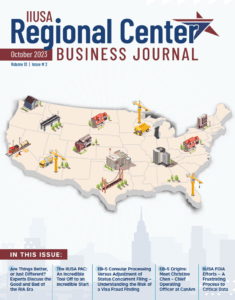 History of Risk in the EB-5 Regional Center Context (Dec. 2013, Vol. 1, Issue 4, Pgs. 20-23)
History of Risk in the EB-5 Regional Center Context (Dec. 2013, Vol. 1, Issue 4, Pgs. 20-23)
By Robert F. Loughran
The Immigrant Investor Program can be a “win-win” for developers, who get access to low-interest capital, and also for the foreign investor who may be principally seeking the non-monetary return of Lawful Permanent Residency in the U.S. However, due to the potentially distorting mix of immigration regulations, there can be situations where the needs of the developer and the needs of the foreign investor do not completely align.
For example, in order to be eligible to file an I-526 petition, the foreign national’s investment must be “at-risk” in the commercial sense. Meaning, the investor’s petition will be denied if USCIS determines that the investor’s investment is not at risk. This requirement of risk in turn means there is no guarantee that the applicant will recover their investment made to the commercial enterprise, and it is this “at-risk” requirement which creates the opportunity for a divergence of interests between the project developer and the individual foreign investor. Added to the commercial risk requirement are numerous other risks connected with investments. It may turn out that a high percentage of commercial enterprises, perhaps a majority, will experience some, or total, loss of investment capital due to poor planning, inexperienced management, outright fraud, or generally un- favorable economic conditions.
One of the risks of the EB-5 program is the continuing compliance of the EB-5 regional center. USCIS may approve a regional center, which then sponsors investments for individual investors. But the investor’s removal of conditions requires continuing compliance of the regional center. Experience shows that USCIS may terminate regional center status for non-compliance with EB-5 program requirements.
Those considering the use of an EB-5 regional center as a means of raising capital should be aware of recent regional center terminations in order to better understand the representations that they, or their agents, may be making to foreign investors and the variety of risks and expectations that exist. Under current immigration procedures and timelines, investors and regional center developers should expect a relationship of no less than five years. The national economic picture, industry performance and even family relationships can evolve dramatically in half a decade and with USCIS approval needed for significant amendments, regional centers may lack the adaptability of those projects that do not require USCIS ratification. Expectations, rights and legal recourses should be spelled out contractually, understood and memorialized. USCIS has terminated participation of EB-5 regional centers four times in the past three years. The reasons for these terminations were generally based on either a lack of economic growth or determinations of potential fraud. Owners and developers should be aware of the legal authority to terminate regional centers and adjust their practices to document ongoing viability. Not only can careful planning reduce economic loss and litigation for potential investors, it may give developers the opportunity to adjust their practices so as to successfully structure and operate their cur- rent or future regional centers. Specific and applicable lessons can be learned from previous regional center failures.
Current Immigration Law Regarding Revocation of CIS Designation
Pursuant to 8 CFR Section 204.6(m)(6), the USCIS may terminate a regional center’s designation for various reasons, including:
1. The regional center fails to submit required information; or
2. The regional center no longer promotes economic growth, including increased ex- port sales, improved regional productivity, job creation, and increased domestic capital investment.
If the regional center is issued a Notice of Intent to Terminate (NOIT), then the regional center must be provided 30 days, from receipt of the NOIT, in which to submit evidence in opposition to the grounds alleged in the NOIT. Furthermore, if the USCIS determines that the regional center’s participation in the program should be terminated, the USCIS shall notify the regional center of the decision and of the reasons for termination.
Summary of Rationale for Revocation of Regional Center’s Designation
In review of four revocation cases, the rationale for the revocations has been as follows:
1. USCIS may revoke a regional center’s designation for lack of job creation.
2. USCIS may revoke a regional center’s designation for failure to promote economic growth. USCIS may question:
a. How many investors have used the regional center in the last few years?
b. Has the regional center or the General Partner of the regional center filed for bankruptcy or otherwise manifested economic weakness?
c. Are the representations made in previous filings born out as factual?
3. USCIS may revoke a regional center’s designation if it fails to demonstrate that its projects will create jobs in verifiable detail based upon a business plan and economic analysis that employs reasonable methodologies for estimating jobs.
4. USCIS will revoke a regional center’s designation where it no longer promotes economic growth in the sense that the regional center’s projects are no longer viable and the regional center entity is no longer overseeing the projects and investments that were outlined in the original request for regional center designation.
Among the lessons learned: If USCIS revokes the regional center designation, foreign investors could be stranded if their immigration cases are in progress. There also exists the possibility that cases previously approved could be reopened and denied if it is deter- mined that previous approvals were based on false statements.
Below, we identify each of the four regional center revocation cases, summarize the regional centers’ case history, and detail the rea- sons for the termination.
Victorville Regional Center
In the case of the Regional Center of Victorville Development, Inc. (Victorville RC), USCIS had approved Victorville RC in June 2009, however, USCIS then terminated Victorville RC on October 10, 2010. After Victorville RC filed a motion, and responded to a subsequent request for evidence, USCIS issued a Final Notice of Termination on May 24, 2011. The Administrative Appeals Office affirmed the decision on December 21, 2011.
The stated rationale of USCIS for terminating the Victorville RC was the regional center failed to promote economic growth through job creation. According to the decision adjudicated by the Administrative Appeals Office, the Victorville RC sought to invest EB-5 capital only after the jobs in question had al- ready been created. According to the record, Victorville RC undertook an Industrial Waste Water Treatment Facility project (IWWTF) which involved bridge financing. Due to the structure of the bridge financing, the IWWTF began hiring employees and construction of the project reached 90% completion before the investors had contributed and invested their EB-5 capital. Therefore, Victorville RC, according to the USCIS, was improperly claiming immigrant investor job creation credit for jobs that existed before EB-5 capital was invested into the project.
El Monte Regional Center
The El Monte Regional Center (El Monte RC) had been approved in June 2008 by US- CIS. Three years later in 2011, USCIS issued notices for terminating El Monte RC. After an unsuccessful motion, the Administrative Appeals Office affirmed the decision to terminate the regional center on July 23, 2012. El Monte RC was terminated because USCIS determined that the regional center could not promote economic growth.
El Monte RC submitted annual reports in 2009 and 2010. In the 2009 annual report, El Monte RC identified a single investor, and in the 2010 report, it identified a second investor. In its notice of July 11, 2011, USCIS cited the following factors:
1. El Monte RC had recruited only 2 investors;
2. El Monte RC had insufficient financial re- sources to deliver on its representations as evidenced by its bankruptcy proceedings; and,
3. El Monte RC did not have title to the property it purported to own.
Lake Buena Vista Regional Center
The Lake Buena Vista Regional Center (LBV RC) was initially approved by USCIS in September 2008. Thereafter, LBV RC filed with USCIS and obtained several approvals of amendments to the regional center designation. Nonetheless, USCIS issued a notice to terminate LBV RC in December 2011, conducted an interview in March 2012, and finally terminated LBV RC in a notice dated July 23, 2012.
According to USCIS, it terminated LBV RC for failure to establish continuing eligibility and compliance with program requirements of promoting economic growth. In particular, USCIS indicated that a statistically valid job creation analysis had not been submitted. The analysis was plagued by errors in data sources and methodologies. Also, for instance, the market competitor analysis indicated significant excess capacity in accommodation services, jeopardizing the ability of LBV RC to meet the requisite EB-5 job creation requirements based on a claim of in- crease in visitor spending. USCIS concluded that LBV RC failed to demonstrate its projects would create jobs in verifiable detail, based upon a business plan and economic analysis that employed reasonable methodologies for estimating job creation through EB-5 capital investment.
Mamtek Regional Center
USCIS had approved Mamtek Regional Center (Mamtek RC) in August 2011. Mamtek RC involved a planned sucralose manufacturing facility in Moberly, Missouri. But within just 3 months of regional center approval, USCIS issued a notice of intent to terminate. USCIS finally terminated Mamtek RC on April 11, 2012. In this case, USCIS had determined upon review of individual investor I-526 petitions filed by Mamtek investors that the proposed capital investment project was not viable.
Mamtek RC was a single member LLC with Mamtek, U.S., Inc. According to the initial business plan, Mamtek U.S., Inc. was the operating company and full owner of Mamtek RC. USCIS later discovered that Mamtek RC was no longer overseeing the projects and in- vestments that Mamtek RC had outlined in its original request for regional center designation. Instead, Mamtek RC was controlled by a new company and supervised by the City of Moberly. Therefore, the USCIS determined that the Mamtek RC could no longer claim credit for the estimated job creation related to the future projects.
In its decision, the USCIS noted that the existence of bankruptcy proceedings against Mamtek U.S., Inc. did not preclude the US- CIS from exercising its power to ensure that Mamtek RC had fulfilled its statutory and regulatory obligations as a regional center. USCIS terminated the approval of the Mamtek RC because it determined that the regional center no longer served the purpose of promoting economic growth. Since then, a lengthy parade of legal proceedings has en- sued, including enforcement action by the State of Missouri. See e.g, http://www.sos.mo.gov/securities/orders/AP-13-10.pdf
Conclusion
Developers and other industry stakeholders can learn much from the terminations of Regional Centers. In particular:
1. The financial projections need to make sense independent of the immigration issues;
2. The financial arrangements, identification of all fees and all parties and agents participating and receiving fees should be disclosed and memorialized;
3. Developers cannot sit on a Regional Center designation, they must attract investors, and begin activity or the approval can be revoked;
4. USCIS can gather contradictory or negative financial information from a variety of public, private and intra agency sources which may trigger revocation;
5. The experience and track record of the managers of the regional center and the developers of the projects are relevant to the long term success of the investments;
6. The economic projections need to be realistic, and perhaps conservative to survive the 5-10 years that a developer could be dependent on USCIS review and approval;
7. Just because you can project significant job creation, does not mean you should rely on the most optimistic projections and take in as many investors as that optimistic projection would “support”;
8. Do unto others as you would have them do unto you;
9. Be prepared to exhaustively document every aspect of the regional center and its projects; and,
10. Do not skimp on professional guidance when every investor is a potential litigant.
RCBJ Retrospective articles are reprinted from IIUSA’s Regional Center Business Journal trade magazine. Opinions expressed within these articles do not necessarily represent the views of IIUSA and are provided for educational purposes.







